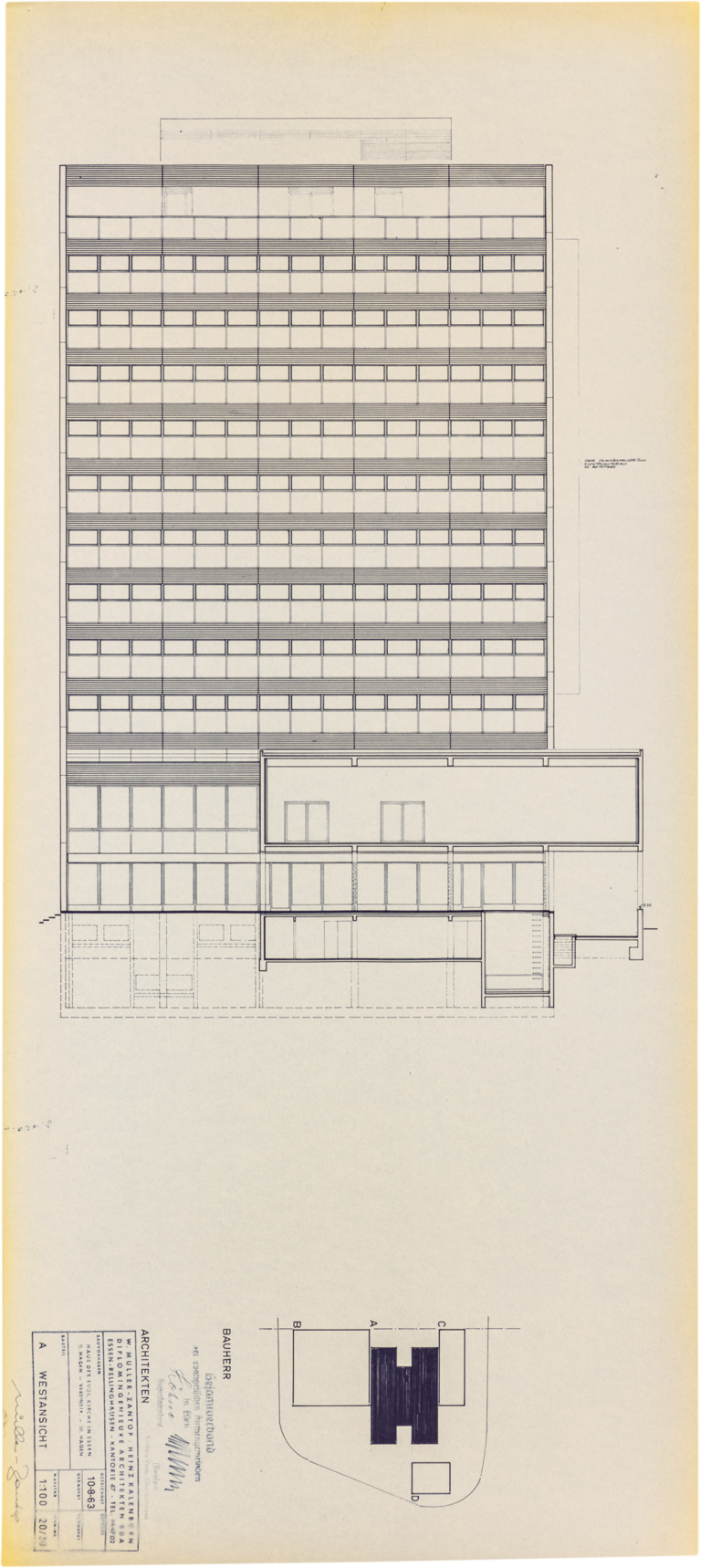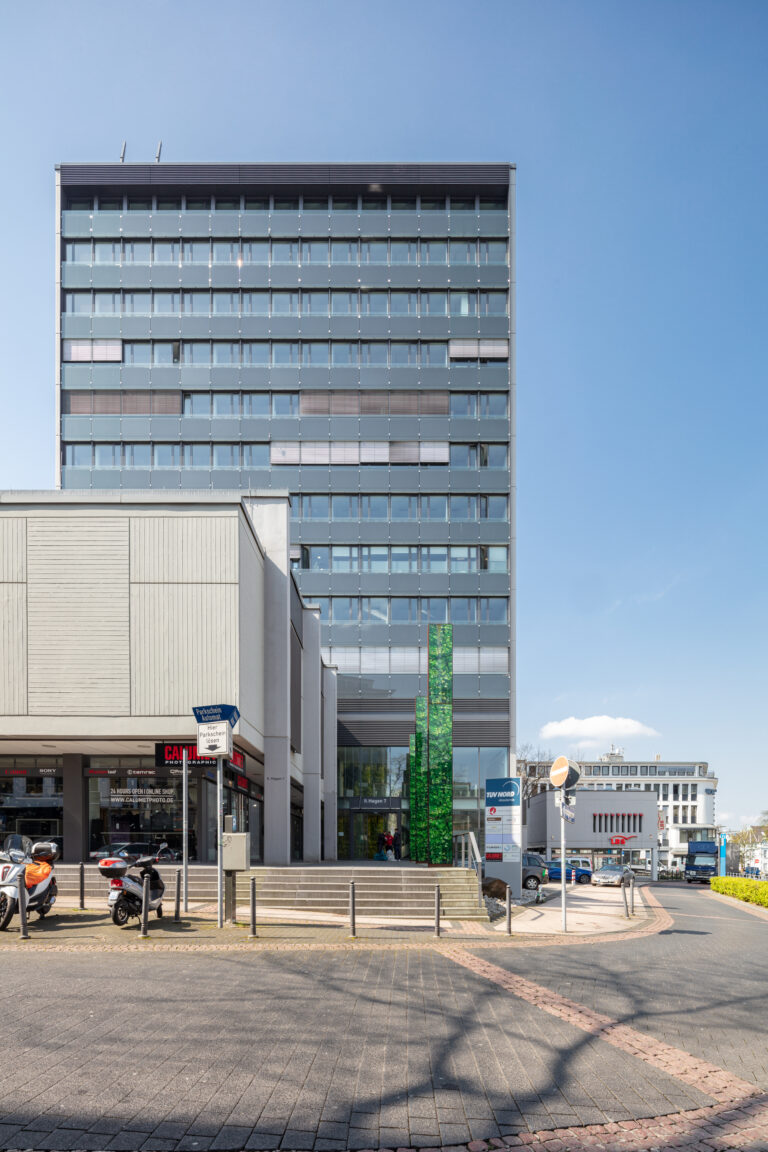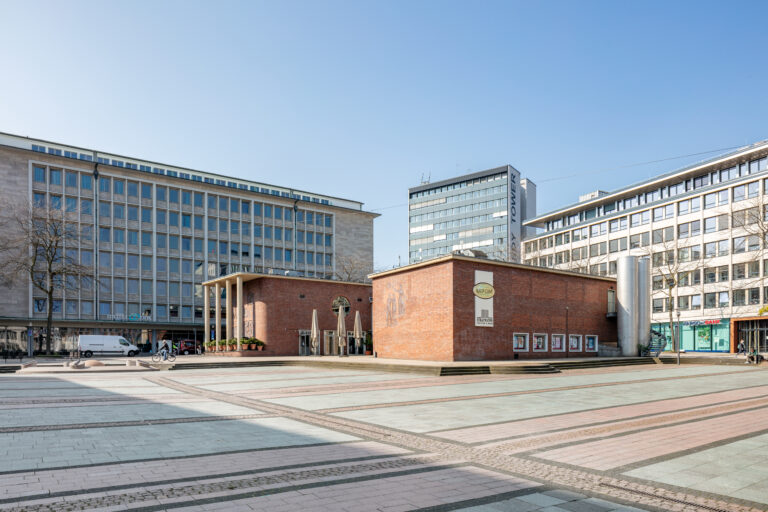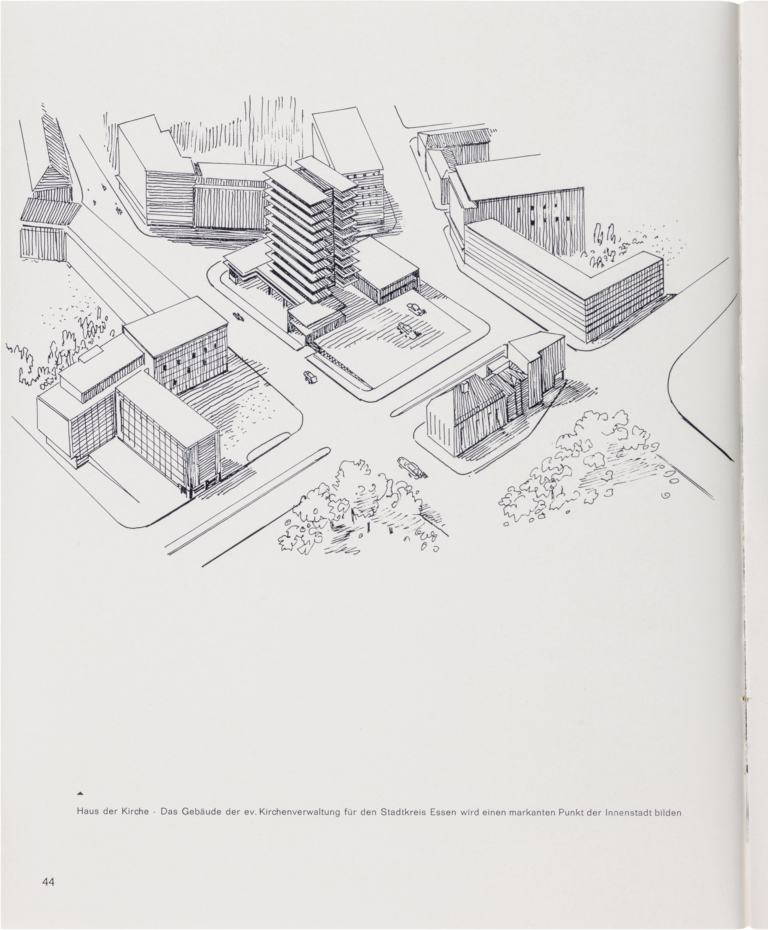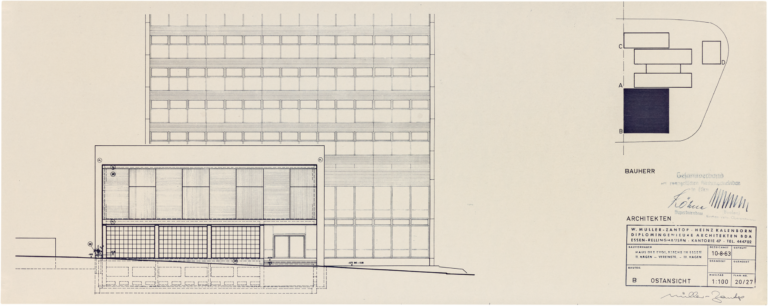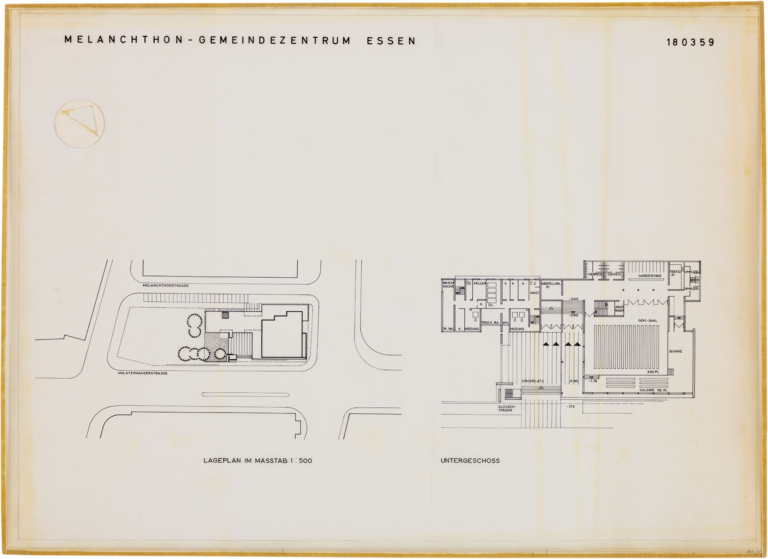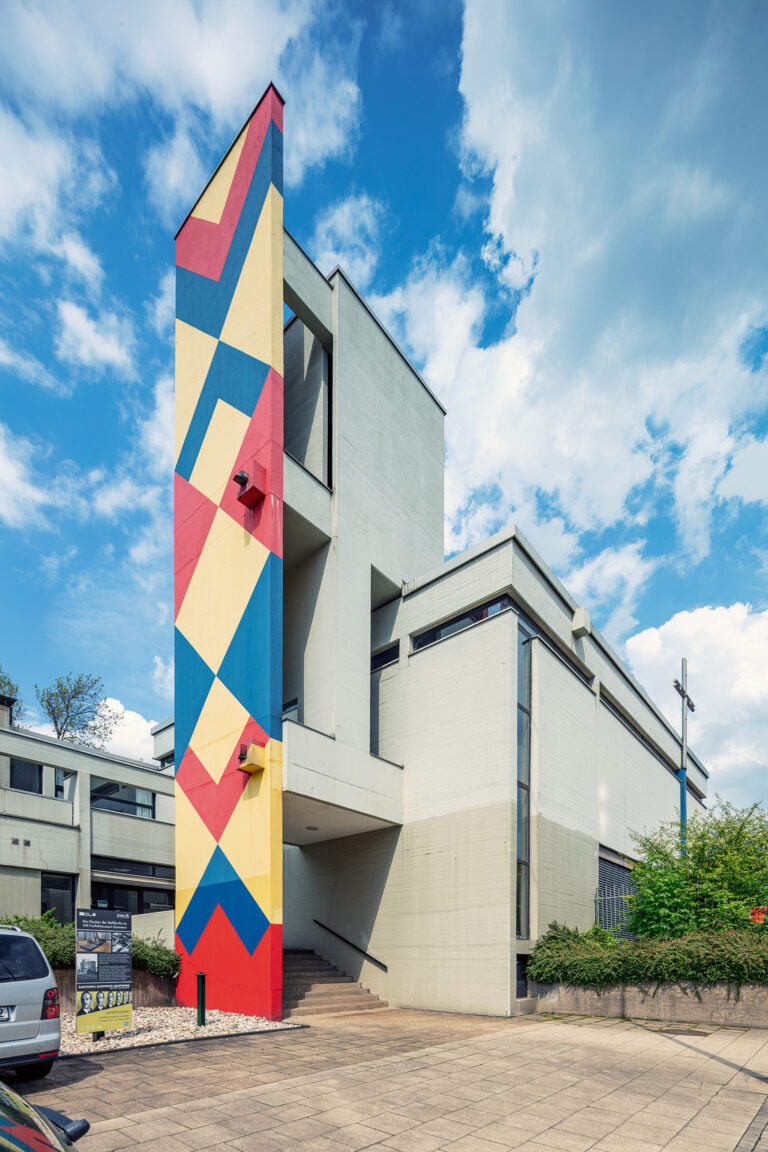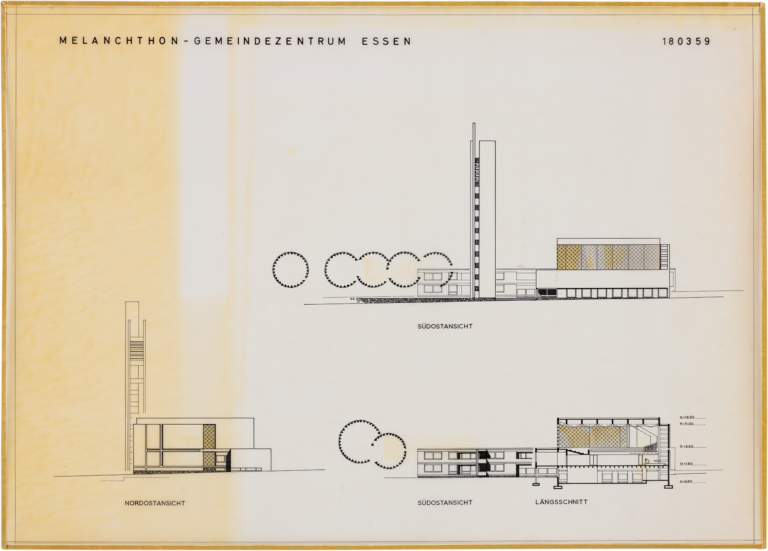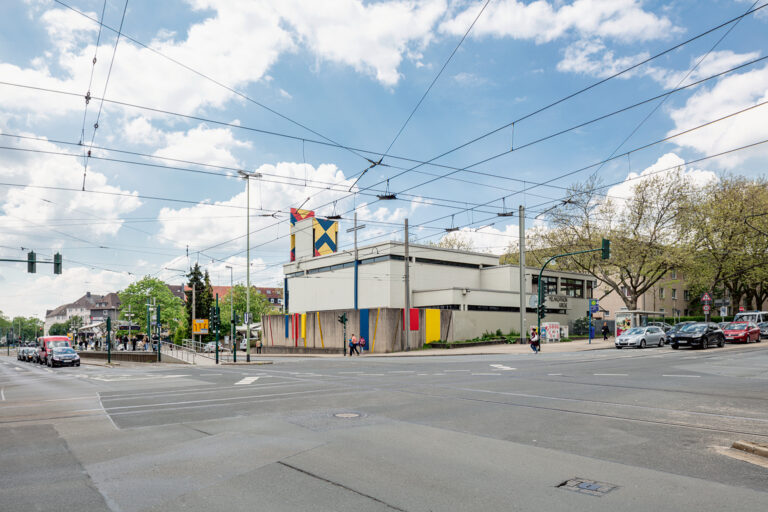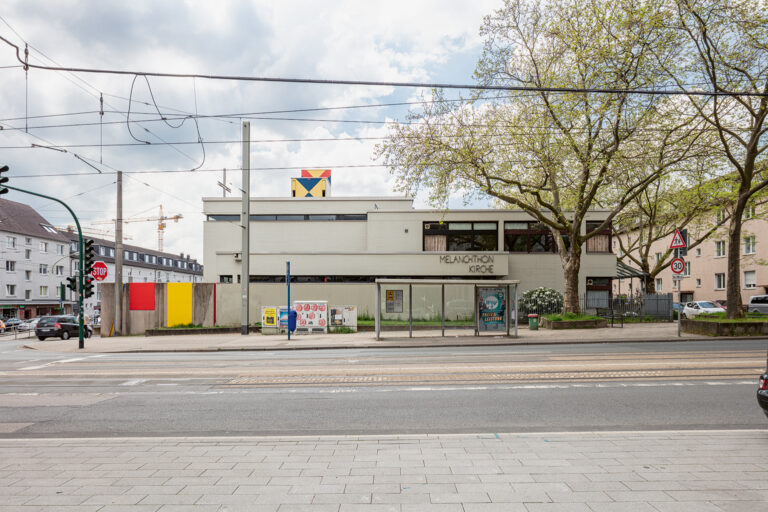Centre and neighbourhood
Sonja PizonkaIn 1959, Cologne Cathedral master architect Willy Weyres and architect Otto Bartning published the “Handbuch für den Kirchenbau” (Handbook for Church Construction). New churches, they wrote, would in future be built mostly in urban districts: “Old town parishes, on the other hand, usually manage with the existing churches, especially as their population has often declined or will decline. The task of building new main churches in the town centres will therefore relatively arise from now on. However, some older churches will still have to be rebuilt, repaired or adapted to new requirements. However, this is usually a process that scarcely modifies the building’s outward appearance.” In Essen, too, the question arose after the Second World War as to what to do with the damaged church buildings in the city centre.
Gildenplatz
While the centrally located sacred buildings, the Münster (Minster) and Marktkirche (Market Church), were repaired, it was decided not to rebuild the nearby Protestant Pauluskirche (St Paul’s Church) consecrated in 1872 due to the small number of parishioners. The ruined nave was demolished, while the surviving steeple remained standing for the time being. The surrounding area, which had been densely built-up before the war, underwent extensive change in the course of reconstruction. A centrally located space was created, the Gildenplatz (since 1963 Kennedyplatz), and new buildings were erected on it, the “Amerikahaus”, a US educational institution, (1952) and the new Heroldhaus (1955), Gildenhaus (1955) and Allbauhaus (1956) multi-storey office buildings. The steeple of the old Pauluskirche continued to loom over this new square, slightly set back from it. In September 1958, the tower was demolished; the site was to be developed with a building of at least eight storeys.
High-rise building
In 1959, a limited architectural competition was held for an administrative building for the Protestant Church. This building was to accommodate, among other things, the entire association of the Protestant Church parish – school department, youth department, youth and synodic library, marriage counselling centre, Diakonisches Werk welfare organisation, social department, relief organisation and church tax office. Several halls for various events were also planned. The competition for this House of the Protestant Church was won by the architects Heinz Kalenborn and Wolfgang Müller-Zantop, who had previously jointly designed the Protestant Markuskirche (St Mark’s Church) and the associated community centre in Essen-Frohnhausen (built in 1958–1960). In 1962, the Office for Economic and Transport Development of the city of Essen wanted to convey a first impression of the future development. In the office’s publication “Essen – Soziale Gross-Stadt von morgen” (Essen – Social City of Tomorrow), there is a perspective drawing of the building, though not by the architects themselves. It is clearly visible that the planned high-rise building – like the church steeple once did – clearly towers over its surroundings.
Tied to the city centre
As an explanation for the high-rise construction, it was noted: “In the process [of rebuilding the city centre], new open spaces were cleared, streets widened and parking spaces created. It is hardly surprising that land became scarce and that the administrative and commercial buildings required in this area had to be clustered tightly together or grow vertically. Even though many organisations and companies moved to the ‘administrative town’ south of the main railway station, some buildings were still tied to the city centre.” In addition to the House of the Protestant Church, these included the new building of the Chamber of Industry and Commerce diagonally opposite. So the church no longer showed itself at this location with a sacred building as an institution of faith; rather, surrounded by other office buildings, it presented itself with its 45-metre-high structure like a company with a head office on the newly created square in the city centre.
Curtain wall and H-shaped ground plan
Kalenborn and Müller-Zantop designed a twelve-storey building with a curtain wall and H-shaped ground plan surrounded by three pavilion buildings. These pavilions contained, among other things, meeting rooms that were used for public functions after the building was completed in 1964. The largest hall, a windowless room with movable seating, which was located in the pavilion to the west, contained a work by Ferdinand Spindel, an artist from Gelsenkirchen associated with the ZERO group. Spindel provided two opposing walls with concave concrete elements that were accentuated by specially installed lighting (#Church St Nicolai; #Church of the Holy Blood). Today, the building is no longer used by the Protestant Church. It was listed as a monument in 2008 and refurbished and converted in 2009 by Böll Architekten in collaboration with Wolfgang Müller-Zantop and Patrick Bayer. Now known as the Kennedy Tower, it is now used as a commercially let office building. The House of the Protestant Church continued to exist after moving out and is now located, just a few doors away, in what used to be the Essen-Nord Tax Office building.
Neighbourhood church
In the city centre, a sacred building had therefore been abandoned in favour of an office building; facilities and services for the congregation and the interested public nevertheless made the building a popular venue. For the neighbourhood churches, too, the question arose as to what uses beyond worship should be possible in a church building. In Essen-Holsterhausen, it was decided to build the Melanchthon community centre with a church hall, community hall, club room, confirmation area, other group rooms and flats. The community centre had a famous predecessor building, the Steel Church by Otto Bartning, destroyed in the war but originally erected in 1928 at the “Pressa” trade fair in Cologne as an example of modern Protestant church building. From the outset, the idea had been to dismantle the Steel Church after the exhibition and make it available to a congregation as a sacred building. It was moved to Holsterhausen in 1931 and went into operation as the Melanchthon-Kirche. After the building was gutted in a bombing raid in 1942, the debris of the steel frame was dismantled. The community hall under the church was rebuilt and served as a makeshift church in the years that followed.
Multi-storey community centre
In the early 1960s, it was finally decided to use the property for a community centre with a new church building, community rooms and flats. The open competition was won in 1964 by the Duisburg architect Peter Voigtländer. The Baukunstarchiv NRW has preliminary drafts, competition documents and initial plans after the contract was awarded. Since Voigtländer died in a car accident in 1965 at the age of only 37, no further plans are available. As with Bartning’s Steel Church, Voigtländer’s design also envisaged a church room on the upper floor and a community hall in the basement. However, this idea was not only derived from the previous building, for Voigtländer had already used similar approaches, at that time still in collaboration with Heiko Stumpf, e.g. on the Protestant church in Möllen in Voerde. As a result of his designs for municipal halls and churches, he already had experience in handling extensive room layouts on small footprints; on this project, he used the slope between Holsterhauser Strasse and Melanchthonstrasse to fit a multi-storey community centre into the site surrounded by roads.
The architect devised a building with numerous rooms for community work on three levels and also took care to screen off the building from street noise. Thus he noted in the explanatory report: “The forecourt where the congregation gathers has been moved into an enclosed precinct, shielded from the traffic junction and elevated by a few steps, and is also a space where the congregation gathers.” In his design of the façade, Voigtländer experimented with different patterns and shapes.
Like an island
The Melanchthon community centre was finally built in 1970–1972 to plans by the architects Jörg-D. Ohm and Hans-Joachim Thielke. The basic features of Voigtländer’s design are still visible in the finished building. The idea of a façade design with a geometric pattern was also retained – it was the artist Otto Herbert Hajek who gave the community centre, which opened in 1972, the striking colour scheme of the belfry in red, yellow and blue and designed the walled square in front of the church hall with the artwork “Begegnen” (Encounter) (#Church of the Holy Blood; #House of Libraries). Commenting on the impact of the building located at a busy road junction in the densely built-up district between schools, the clinic and shops, the Church authority wrote: “The building consists of structures of different heights and dominates Holsterhauser Platz with its idiosyncratic, geometrically functional style. It thus stands out from the surrounding housing – like an island.”
The present text was first published in: Hans-Jürgen Lechtreck, Wolfgang Sonne, Barbara Welzel (ed.): Religion@Stadt_Bauten_Ruhr, Dortmund 2021, pp. 262–273.
